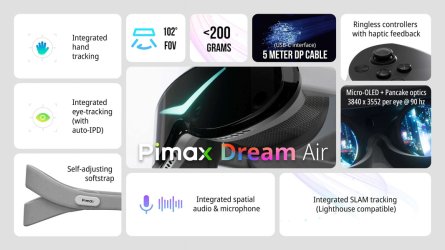TheLostSwede
News Editor
- Joined
- Nov 11, 2004
- Messages
- 18,934 (2.51/day)
- Location
- Sweden
| System Name | Overlord Mk MLI |
|---|---|
| Processor | AMD Ryzen 7 7800X3D |
| Motherboard | Gigabyte X670E Aorus Master |
| Cooling | Noctua NH-D15 SE with offsets |
| Memory | 32GB Team T-Create Expert DDR5 6000 MHz @ CL30-34-34-68 |
| Video Card(s) | Gainward GeForce RTX 4080 Phantom GS |
| Storage | 1TB Solidigm P44 Pro, 2 TB Corsair MP600 Pro, 2TB Kingston KC3000 |
| Display(s) | Acer XV272K LVbmiipruzx 4K@160Hz |
| Case | Fractal Design Torrent Compact |
| Audio Device(s) | Corsair Virtuoso SE |
| Power Supply | be quiet! Pure Power 12 M 850 W |
| Mouse | Logitech G502 Lightspeed |
| Keyboard | Corsair K70 Max |
| Software | Windows 10 Pro |
| Benchmark Scores | https://valid.x86.fr/yfsd9w |
Pimax, a manufacturer of leading VR hardware, released in an online keynote presentation the design and specs of an upcoming headset, the Pimax Dream Air. The small and light headset packs 27 million pixels, head, hand and eye-tracking, integrated spatial audio, a DisplayPort connection, and a self-adjusting backstrap.
The Dream Air is a PCVR headset, and borrows a lot of components from the previously announced Crystal Super, including the micro-OLED panels and pancake lenses—but packs this into a small form factor headset, to satisfy different use cases. It breaks with previous Pimax headsets, with a new design language, signalling the small form factor era for Pimax.




Key Features:
Pimax acknowledges the diverse needs of VR users. While the Crystal Super excels as the ultimate PCVR headset for seated simulation experiences like flight and racing, the Dream Air is tailored for active VR users. Its portability and lightweight design cater to applications such as VRChat, room-scale VR, and entertainment on the go.
Expanding VR Beyond the PC
Pimax is also developing Cobb, a standalone device powered by a Snapdragon XR2 chip and battery. Cobb enables the Dream Air to operate independently for streaming movies, running light applications, or gaming, offering even greater versatility.
Pricing & Availability
The price of Pimax Dream Air starts from $1,895, which includes a pair of ringless controllers. A special pre-order price of $1,199 is available, with two payment options for the balance:
One-Time Payment of $696 USD (12% discount).
Or, 24 Monthly Payments of $32.99 USD through Prime membership.
Shipping is expected to begin in May 2025.
View at TechPowerUp Main Site | Source
The Dream Air is a PCVR headset, and borrows a lot of components from the previously announced Crystal Super, including the micro-OLED panels and pancake lenses—but packs this into a small form factor headset, to satisfy different use cases. It breaks with previous Pimax headsets, with a new design language, signalling the small form factor era for Pimax.




Key Features:
- Integrated Eye-Tracking & Auto-IPD: Ensures optimal clarity and interaction.
- Inside-Out Tracking: Powered by Pimax's proprietary SLAM algorithm for seamless setup without base stations.
- Ringless Controllers & Hand Tracking: Enhances usability for gaming and other VR applications.
- Spatial Audio & Lightweight Design: Provides premium sound and a form factor that weighs less than half a Coca-Cola bottle.
- Type-C DisplayPort Cable: Ensures uncompressed visuals with ultra-light cabling.
- Future-Ready: Compatible with modular accessories like prescription lenses and a planned Lighthouse faceplate for users preferring external tracking systems.
Pimax acknowledges the diverse needs of VR users. While the Crystal Super excels as the ultimate PCVR headset for seated simulation experiences like flight and racing, the Dream Air is tailored for active VR users. Its portability and lightweight design cater to applications such as VRChat, room-scale VR, and entertainment on the go.
Expanding VR Beyond the PC
Pimax is also developing Cobb, a standalone device powered by a Snapdragon XR2 chip and battery. Cobb enables the Dream Air to operate independently for streaming movies, running light applications, or gaming, offering even greater versatility.
Pricing & Availability
The price of Pimax Dream Air starts from $1,895, which includes a pair of ringless controllers. A special pre-order price of $1,199 is available, with two payment options for the balance:
One-Time Payment of $696 USD (12% discount).
Or, 24 Monthly Payments of $32.99 USD through Prime membership.
Shipping is expected to begin in May 2025.
View at TechPowerUp Main Site | Source








